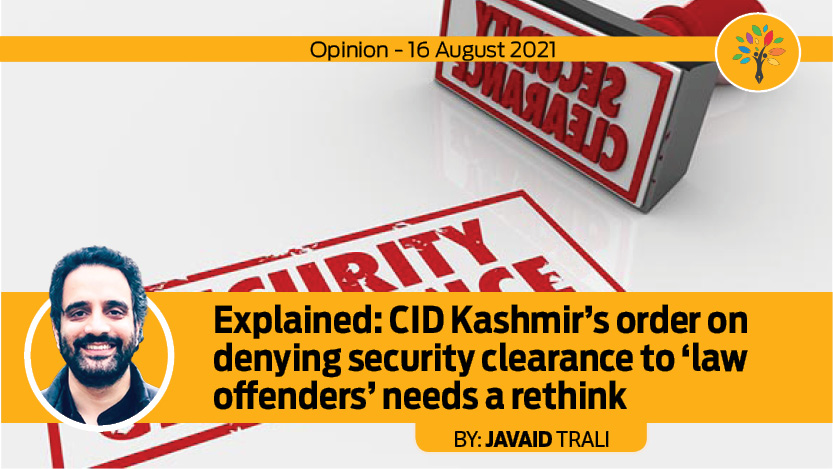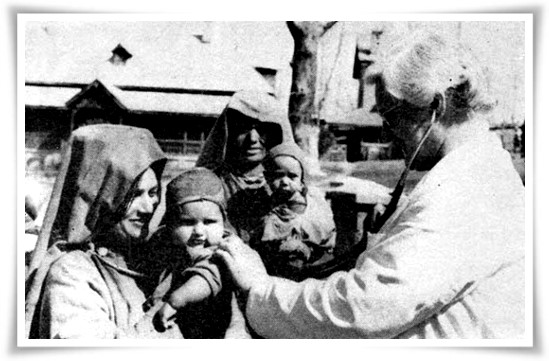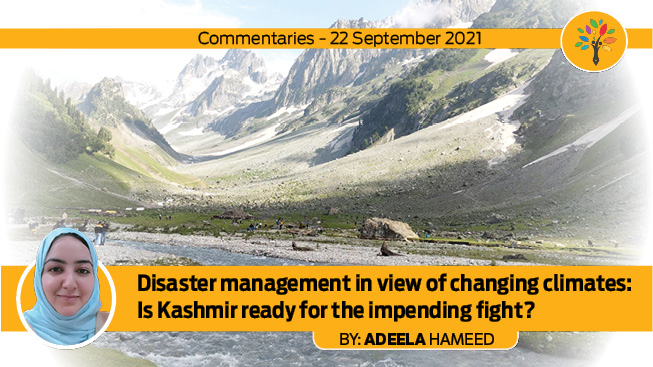On July 31, 2021, the Criminal Investigation Department (CID) of the Jammu and Kashmir Police issued an order, denying security clearance for passports and other government services to all those involved in “law and order and stone-pelting cases”.
“All the field units of CID SB Kashmir are hereby directed to ensure that during verification related to passport, services and any other verification to government services/schemes, the subjects involvement in law and order, stone-pelting cases and other crime prejudicial to the security of the state be specifically looked into and same must be corroborated from the local police station records,” reads the order issued by the Senior Superintendent of Police (SSP), CID.
The order added that any digital evidence like CCTV footage, photographs, videos and audio clips, quadcopter images available in the records of the police, security forces, and security agencies be also referred during the verification process. “Any subject found involved in any such cases must be denied the security clearance.”
The “strict” security procedures laid down in the aforementioned order may be deemed necessary and acceptable at the law enforcement level but, speaking in a personal capacity, need a rethink because in their current form they do not remain subject to the checks and balances. Therefore, discounting the clutter born out of picking holes in this order by looking at it through political lenses, here is why it should be reviewed.
To begin with let’s ask ourselves a simple question: why has armed militancy continued here for over 30 years now despite huge military might being employed to thwart and wipe it out? The simple answer is because a hostile neighbouring state has a tap on it, and its continued support to cross-border terrorism is the major lifeline of the militancy in Kashmir – and unless these support structures are closed down, militancy will continue here.
This is the statement of fact. But, at the same time, it’s a reductionist description of the reality – only a partial truth.
Conflict is like fire and should be seen and treated as such. The fire triangle or combustion triangle is a simple model for understanding the necessary ingredients for most fires. The triangle illustrates the three elements a fire needs to ignite: heat, fuel, and an oxidizing agent (usually oxygen). A fire occurs when these elements are present and combined in the right mixture. Take out any of the three elements and the fire triangle will cease to exist – meaning that the fire would go out, be put off.
If the constant stream of provocations in the wake of continued situational turbulence and strife here accounts for the ‘heat’ or the ‘kindling temperature’, the ‘fuel’ is the people of Kashmir, the young people with a certain radicalized worldview’. The ‘oxidizing agent’ or ‘supporter of combustion’ is the political and material (read military and financial) support that comes from across the border.
Leaving alone the cross-border support (the oxidizing agent), which has somehow attracted and consumed overly disproportionate attention and energy so far, the simple and elementary wisdom of firefighting will focus on the other two elements to put out the fire in Kashmir.
Instead of just harping on the neighbouring country’s support to the cross-border terrorism and trying to beseech or coerce it into stopping this support, it’s time for New Delhi to concentrate on the two other elements – available within.
It should try to stop ‘heat’ by putting an end to the constant provocations — both real and the ones perceived so by the recipient population. It should also stop the supply of ‘fuel’ by dissuading Kashmir’s young and the old from being lured towards, and into militancy. Both these things are completely and easily doable.
This way, instead of, and unlike the neighboring country, India could have (and actually has) a tap on two essential elements. Understandably then, if its adversary has been or is able to start and increase or decrease the intensity of the fire in Kashmir at its requirement and liking, with a little bit of imagination and creativity the Government of India can put it off at will. Period.
Having laid down this [common sense] context, now let’s ask if the latest police order is in sync with what is needed. Will it stop the supply of two of the identified elements – heat and fuel — to the fire or increase their availability? The answer to this simple question should explain why a review and rethink of the order is sought.
It is accepted that most of the stone-pelting clashes that Kashmir has witnessed in previous years were meticulously orchestrated by certain actors/forces who had a visible vested interest in provoking law and order problems to keep the proverbial pot boiling here. Yet there is a good reason to infer and believe that not everyone who was actually involved in throwing stones was motivated by the politics and political manipulations behind such troubles.
Given their age, and lack of educational, social and political capital to read through and understand the designs of the ringleaders and trouble-makers, many young people, and at times even children would be drawn towards stone-pelting in the heat of the moment. They would partake in pitched battles because it would push and pump adrenaline in their young bodies. People of their age crave it; it’s like stunt biking!
In normal situations and circumstances, young people, the adrenaline junkies satiate this need through sporting and recreational activities, adventure outings and similar pursuits. But here in Kashmir, such pastimes have remained suspended for ages, and nobody had seemingly thought of the need to provide the young population with the normal and necessary avenues to vent out their rage. So they took to stone-pelting because this was the only available activity.
Now most of them didn’t have the faculties and the acumen to understand how it could spoil their future, their careers. It must be understood that if they could overlook the far graver dangers it posed to their life and limb (hundreds of people have lost their lives to these clashes and thousands have been wounded, some with very grave and life-long injuries) they could certainly not be bogged down by threats to their careers.
Now all this is not being said to condone or justify stone-pelting. The point that is being made is that people do indulge in such nasty activities at a certain age. This is where clever and careful parenting comes into the picture.
The state too has to be and behave like a magnanimous parent. It cannot condemn and push a kid for her/his nastiness to a point of no return — where the latter feels stripped of parental love, care and concern. Pushed to the wall, such children often find themselves helplessly rolling into the recesses of crime and criminality. This is why the children even when involved in serious crimes are not treated at par with, or interned with the hardcore criminals in mainstream jails. In fact, the entire reason and logic of having a separate juvenile justice system is premised on this thinking.
It is not argued that all those who have been involved in the stone-pelting have been minors, but minors certainly have formed a substantive chunk. And in most of the cases, at the time of anyone being indexed as stone-pelter in police records, or caught on camera or any other evidence while throwing rocks would have been a minor, or maybe a few years older than the minor. In either case, they too deserve some kindness, a possible pardon. Parents do not always throw out their delinquent children; they try to reform them with care and concern.
There is another possibility. Those well-versed with policing will know that not everyone who is indexed in the criminal records is actually a criminal. Some people figure there just because they were at the wrong place at the wrong time. For instance, there are quite a few people who were caught for stone-pelting simply because a police party chasing a group of stone-throwers bumped into them.
Any active and habitual (read ‘professional’) stone-pelter will testify (and any experienced police officer would attest to it) that before throwing stones he would make sure that his back is watched, end secured, and escape route decided. So the likelihood of him being caught during active action is very minimal. There are fairly good chances that the people who were caught during active clashes, were either not active stone-throwers or were simply passing the area when they got sucked/caught in the middle.
There are also cases of some people having been framed as stone-pelters because someone in their neighbourhood didn’t like them for some personal reasons!
It is nobody’s case to argue that everyone whose name figures in the police records as being involved in law and order problems and/or stone-pelting cases is innocent. But it is also true that not everyone who figures in the police records is actually culpable and involved; some innocent people also figure in records for one or the other reason, argued above or not argued, or not even known at all.
So there is certainly merit in taking a lenient view of everyone’s complicity, particularly of those who are not serial and serious offenders. There is a maxim in law: “Let hundred guilty be acquitted but one innocent should not be convicted.”
The new police order, unfortunately, smacks of a resounding punch from a punitive teacher to the face of an unruly student, a kick in his butt; when actually there is need for just a stern pull at his ear with a warning to behave! Excision of an ailing tooth or amputation of a body part has only to be the last resort – it cannot be substituted for a good dose of antibiotics.
Now let’s move to the other and far more important aspect. In the wake of almost every single firefight between the militants and the security forces, the police press releases inform the general public that once the “presence of terrorists in a certain area is ascertained, they are given an opportunity to surrender.” At times even the parents and relatives of the holed up militants are brought to the encounter sites so that they appeal their wards to lay down arms. In many situations, this tactic works and dozens of surrenders have thus far been secured even during the heat of the raging encounters.
Why is this done? What happens to a militant who surrenders thus? Is there a provision for his reintegration or “joining the mainstream” as is the cliché? If upon securing his surrender a militant could be pardoned and allowed to rejoin the mainstream society, there is no reason why anyone who has been involved in stone-pelting or has been indexed as stone-pelter because someone implicated him falsely, should forever be condemned and not given security clearance for a passport or a government job.
Now if the stone-pelters or those involved in comparatively minor law and order offences are treated as such, then the obvious inference is that the state has also shut its doors on the possibility of any militant laying down arms and surrendering. By extension, this would also mean that from now onwards, there is no room or possibility for any militant to surrender and be reintegrated into mainstream society. This would also mean that there is only one possible end for them – that they will be killed.
What does this mean? Again cutting down on any possible clutter for the fear that it may glorify such deaths, means that every militant is now a potential suicide bomber. By the government’s own admissions, there are currently some 200-250 militants here. What the presence of such a large number of suicide bombers means and entails for the general security situation, as also that of the state and its institutions, its VVIPs and other important figures should not be difficult to understand?
Actually, one of the reasons for the continuation of militancy in Kashmir has been and is also the absence of a comprehensive and viable DDR (disarmament, demobilization and reintegration) policy. There have been some attempts at having such a policy in place, but every time the half-hearted efforts in this direction only ended up creating more confusion, and no framework for the reintegration of the former combatants into mainstream society.
This should also explain why there have been increased instances of militants getting recycled not once but in repeated cycles. Security experts would testify that recycled militants are far more hardened and rigid and heartless in their approach and behavior, and obviously a bigger headache for the system.
Wisdom lies in not adding more fuel to the already raging fire. If the aim is to put it out, then ways and means should be devised to stop the supply of two essential elements — heat and fuel. Unfortunately, the new police order has every potential to do otherwise.
References






Leave a Reply
You must belogged in to post a comment.